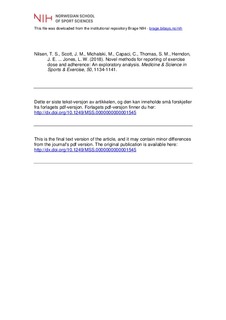| dc.contributor.author | Nilsen, Tormod Skogstad | |
| dc.contributor.author | Scott, Jessica M. | |
| dc.contributor.author | Michalski, Meghan | |
| dc.contributor.author | Capaci, Catherine | |
| dc.contributor.author | Thomas, Samantha M | |
| dc.contributor.author | Herndon, James E | |
| dc.contributor.author | Sasso, John | |
| dc.contributor.author | Eves, Neil D | |
| dc.contributor.author | Jones, Lee W. | |
| dc.date.accessioned | 2019-01-04T12:00:01Z | |
| dc.date.available | 2019-01-04T12:00:01Z | |
| dc.date.created | 2018-10-11T13:21:46Z | |
| dc.date.issued | 2018 | |
| dc.identifier.citation | Medicine & Science in Sports & Exercise. 2018, 50, 1134-1141. | nb_NO |
| dc.identifier.issn | 0195-9131 | |
| dc.identifier.uri | http://hdl.handle.net/11250/2579192 | |
| dc.description | I Brage finner du siste tekst-versjon av artikkelen, og den kan inneholde ubetydelige forskjeller fra forlagets pdf-versjon. Forlagets pdf-versjon finner du på ovid.com / In Brage you'll find the final text version of the article, and it may contain insignificant differences from the journal's pdf version. The definitive version is available at ovid.com | nb_NO |
| dc.description.abstract | Purpose: The purpose of this study was to explore whether methods adapted from oncology pharmacological trials have utility in reporting adherence (tolerability) of exercise treatment in cancer. Methods: Using a retrospective analysis of a randomized trial, 25 prostate cancer patients received an aerobic training regimen of 72 supervised treadmill walking sessions delivered thrice weekly between 55% and 100% of exercise capacity for 24 consecutive weeks. Treatment adherence (tolerability) was assessed using conventional (lost to follow-up and attendance) and exploratory (e.g., permanent discontinuation, dose modification, and relative dose intensity) outcomes. Results: The mean total cumulative ‘‘planned’’ and ‘‘completed’’ dose was 200.7 T 47.6 and 153.8 T 68.8 METIh, respectively, equating to a mean relative dose intensity of 77% T 24%. Two patients (8%) were lost to follow-up, and mean attendance was 79%. A total of 6 (24%) of 25 patients permanently discontinued aerobic training before week 24. Aerobic training was interrupted (missing Q3 consecutive sessions) or dose reduced in a total of 11 (44%) and 24 (96%) patients, respectively; a total 185 (10%) of 1800 training sessions required dose reduction owing to both health-related (all nonserious) and non–health-related adverse events. Eighteen (72%) patients required at least one session to be terminated early; a total of 59 (3%) sessions required early termination. Conclusions: Novel methods for the conduct and reporting of exercise treatment adherence and tolerability may provide important information beyond conventional metrics in patients with cancer. | nb_NO |
| dc.language.iso | eng | nb_NO |
| dc.subject | aged | |
| dc.subject | exercise therapy | |
| dc.subject | exercise tolerance | |
| dc.subject | humans | |
| dc.subject | male | |
| dc.subject | middle aged | |
| dc.subject | patient compliance / statistics & numerical data* | |
| dc.subject | prostatic neoplasms / therapy* | |
| dc.subject | research design | |
| dc.subject | retrospective studies | |
| dc.subject | walking | |
| dc.title | Novel Methods for Reporting of Exercise Dose and Adherence: An Exploratory Analysis | nb_NO |
| dc.type | Journal article | nb_NO |
| dc.type | Peer reviewed | nb_NO |
| dc.description.version | acceptedVersion | nb_NO |
| dc.source.journal | Medicine & Science in Sports & Exercise | nb_NO |
| dc.identifier.doi | 10.1249/MSS.0000000000001545 | |
| dc.identifier.cristin | 1619684 | |
| dc.description.localcode | Seksjon for fysisk prestasjonsevne / Department of Physical Performance | nb_NO |
| cristin.unitcode | 150,31,0,0 | |
| cristin.unitname | Seksjon for fysisk prestasjonsevne | |
| cristin.ispublished | true | |
| cristin.fulltext | postprint | |
| cristin.qualitycode | 2 | |
